What are Fluorochemical products?
2024-10-15
Fluorochemical products are a broad category of chemical compounds that contain fluorine atoms. These products are known for their unique chemical properties, such as high thermal stability, chemical inertness, low surface energy, and resistance to solvents, acids, and bases. Because of these characteristics, fluorochemicals are used in a wide range of industrial and commercial applications.
Common Types of Fluorochemical Products:
1. Fluoropolymers:
- Examples: Polytetrafluoroethylene (PTFE), Fluorinated ethylene propylene (FEP), Perfluoroalkoxy (PFA).
- Uses: Non-stick coatings (like Teflon), wire insulation, seals, gaskets, and chemical-resistant linings.
- Properties: Extremely high resistance to heat, chemicals, and electricity, with low friction properties.
2. Fluoroelastomers:
- Examples: Viton, Fluorosilicone.
- Uses: O-rings, seals, and gaskets in the automotive, aerospace, and chemical industries.
- Properties: High resistance to chemicals, fuels, and high temperatures, making them ideal for demanding environments.
3. Fluorosurfactants:
- Examples: Perfluorooctanoic acid (PFOA), Perfluorooctanesulfonic acid (PFOS).
- Uses: Coatings for textiles, papers, and carpets to make them water-, oil-, and stain-repellent; also used in firefighting foams.
- Properties: Very low surface tension, which allows them to spread across surfaces and repel liquids.
4. Refrigerants (Fluorocarbons and Hydrofluorocarbons, HFCs):
- Examples: R-134a, R-410A, R-22 (phased out due to environmental regulations).
- Uses: Refrigerants used in air conditioning, refrigeration systems, and heat pumps.
- Properties: High efficiency in heat exchange and non-flammability, though some are being phased out due to their global warming potential.
5. Fluorinated Solvents:
- Examples: Fluorinated ketones, ethers.
- Uses: Specialty cleaning applications, electronics cleaning, and precision cleaning where high performance and low residue are important.
- Properties: High solvency power with low toxicity and environmental impact (depending on the specific solvent).
6. Fluorinated Coatings:
- Examples: Fluoropolymer coatings, fluoroalkyl substances.
- Uses: Used in paints, protective coatings for buildings, aerospace components, and cookware.
- Properties: High durability, excellent resistance to weathering, UV radiation, and chemicals.

Key Properties of Fluorochemicals:
- High Chemical Resistance: Fluorochemicals can resist corrosion and degradation when exposed to harsh chemicals, acids, and solvents.
- Thermal Stability: Fluorochemicals remain stable and functional at extreme temperatures, both high and low.
- Non-stick and Low Friction: Many fluorochemicals, particularly fluoropolymers, have non-stick properties and extremely low coefficients of friction.
- Water and Oil Repellency: Fluorochemicals are hydrophobic and oleophobic, meaning they repel water and oils, which makes them ideal for coatings and protective layers.
- Environmental and Health Concerns: Certain fluorochemicals, especially long-chain perfluorinated compounds like PFOA and PFOS, are being phased out due to concerns about their persistence in the environment and potential health risks.
Applications of Fluorochemical Products:
- Aerospace and Automotive: Used in seals, gaskets, and coatings due to their high-performance capabilities in extreme conditions.
- Electronics: As insulators and protective coatings for sensitive components.
- Medical: Used in surgical devices, implants, and drug delivery systems.
- Textiles and Apparel: Used to create water- and stain-repellent fabrics.
- Household Products: Non-stick cookware and stain-resistant carpets are common consumer applications of fluorochemicals.
In recent years, there has been growing concern over the environmental impact of some fluorochemicals, especially those that are persistent and bioaccumulative, leading to regulatory efforts to phase out or limit certain compounds.


